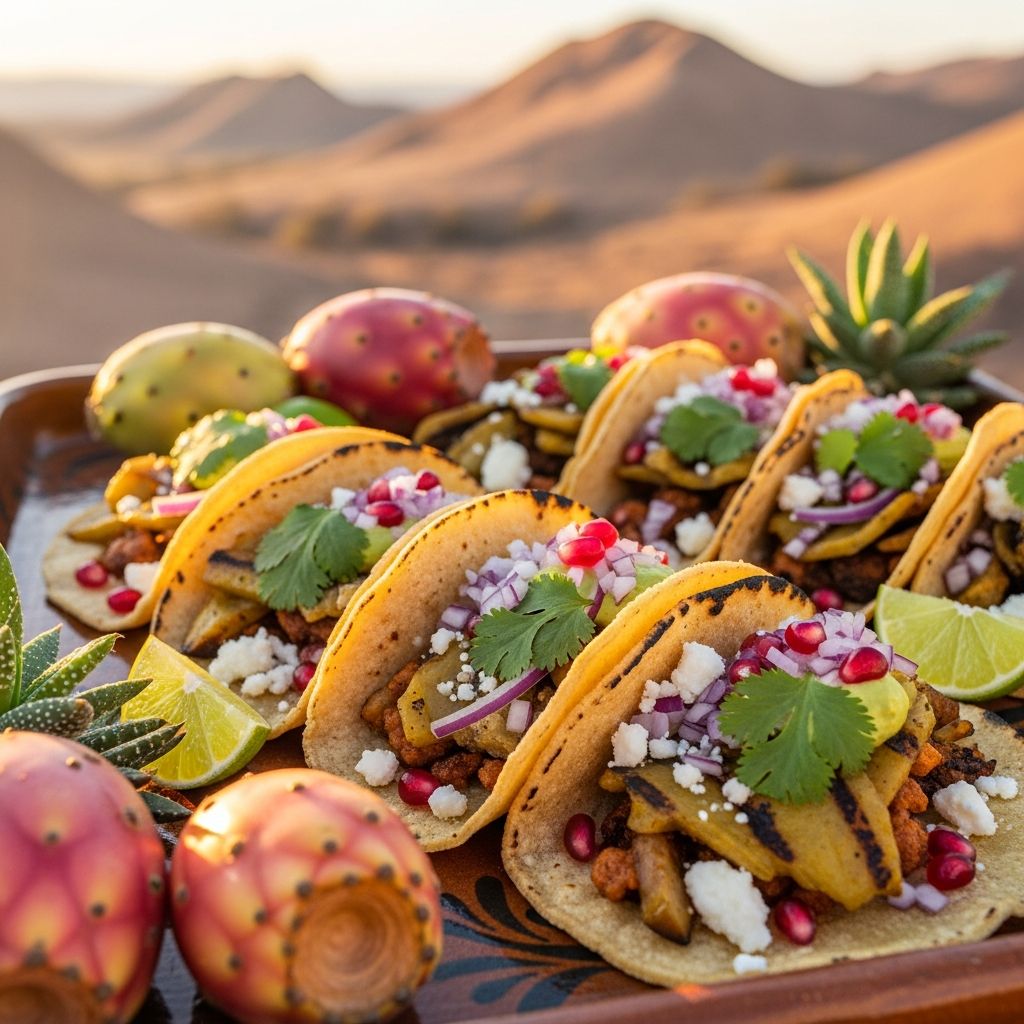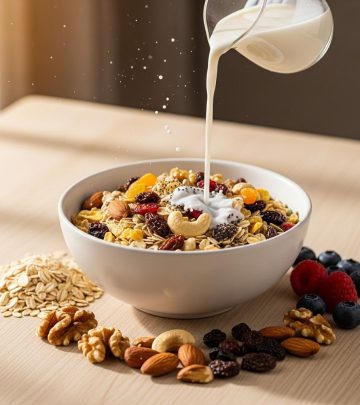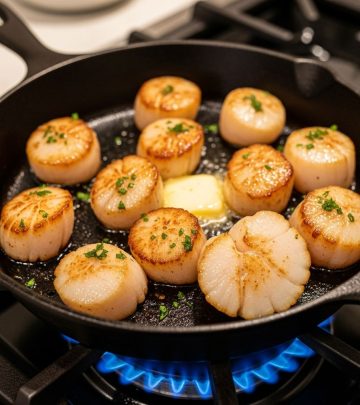Prickly Pear Tacos: A Desert-Inspired Vegetarian Fiesta
Fresh cactus pads, smoky grill flavor, vibrant slaw—discover how to make traditional prickly pear tacos for a true taste of the Southwest.

Introduction to Prickly Pear Tacos
Tacos are a cornerstone of Mexican cuisine, celebrated for their adaptability and regional variations. Among the most unique ingredients making their way into the heart of the taco tradition is the prickly pear cactus pad, also known as nopales. This article explores the culinary magic of prickly pear tacos, from their origins in the Sonoran desert to modern vegetarian interpretations that highlight their distinct flavor and texture. We’ll take you through every stage: ingredient selection, preparation, grilling techniques, taco assembly, serving tips, and frequently asked questions.
What are Prickly Pear Cactus Pads (Nopales)?
Nopales are the young, tender pads of the prickly pear cactus. Used for centuries in Mexican cookery, these paddles are celebrated for their crunchy texture, tart flavor, and nutrient-rich profile. They are high in vitamins, minerals, and fiber, and are traditionally believed to help regulate blood sugar. Their subtle tang and ability to absorb smoky grill notes make them a standout vegetarian taco filling.
- Flavor: Mildly tart, slightly grassy, with juicy crunch
- Texture: Crisp when grilled, tender with a pleasant bite
- Health benefits: High in Vitamin C, calcium, antioxidants
- Traditional uses: Salads, stews, grilled filling, and tacos across Mexico
Ingredients for Prickly Pear Tacos
The basic recipe calls for a balance of grilled cactus pads, protein-rich black beans, bright vegetables, and tangy cheese. Here is an organized breakdown:
| Ingredient | Role |
|---|---|
| 2–3 prickly pear cactus pads (nopales) | Main filling: grilled for smoky flavor and texture |
| 1 large onion | Sweetens and adds umami when grilled |
| 1 (15-oz) can black beans, drained | Provides protein & heartiness |
| 1/2 tsp cumin | Spices and deepens bean flavor |
| 1/2 cup cotija cheese | Finishing touch, salty richness |
| 2 cups cabbage, finely sliced | Slaw base, adds crunch |
| 2 tsp olive oil | Dressing for slaw and grilling |
| 1 tbsp lime juice | Tang for slaw, balances flavors |
| 1 large handful cilantro | Herbal freshness |
| 12 small corn tortillas | Traditional taco shell |
| Kosher salt and pepper | Balances seasoning |
Preparing Prickly Pear Pads
Proper preparation is crucial to safely and deliciously enjoy cactus pads. Follow these key steps:
- Harvesting: If using pads from your yard, select new, tender growths. Use heavy gloves and a sharp knife to avoid the spines.
- Cleaning: Scrape off all visible thorns and “glocids” (tiny, hair-like spines) with a knife or vegetable peeler. Rinse thoroughly.
- Slicing: Pat dry and brush with olive oil for grilling.
Making the Cabbage Slaw
This vibrant slaw brings brightness and crunch to balance the earthiness of the grilled cactus. The process:
- Mix olive oil, lime juice, kosher salt, and pepper in a mixing bowl.
- Add the sliced cabbage and roughly chopped cilantro; toss until evenly coated.
- Let the slaw sit to marinate while preparing the rest of the meal, allowing flavors to meld.
Preparing the Black Beans
Black beans provide protein and a creamy base, pairing well with grilled nopales. Steps:
- Drain and rinse canned black beans.
- Add cumin and a pinch of salt; warm gently in a saucepan while prepping other ingredients.
Grilling Cactus Pads and Onions
Grilling is the best way to bring out the deep flavor of cactus pads. Here’s how:
- Slice the onion thickly and brush both cactus pads and onion slices with olive oil; sprinkle with kosher salt.
- Preheat grill to medium-high.
- Place cactus pads and onion slices directly on the grill. Watch for charred spots on the cactus—this signals readiness to flip.
- Cook until cactus pads are tender and nicely charred (about 3–4 minutes per side), and onion slices are soft and browned.
- Warm tortillas briefly on the grill for a toasty finish.
Assembly: Building the Perfect Prickly Pear Taco
Follow these assembly steps for delicious results:
- Chop grilled cactus: Slice into strips, about the same width as the onions for uniform filling.
- Prepare onions: Slice grilled onions into half-moons for easier layering.
- Layering: On each warmed tortilla, add a spoonful of black beans, top with cactus strips and grilled onions, sprinkle with cotija cheese, and finish with cabbage slaw and fresh cilantro.
Serving Suggestions & Variations
Prickly pear tacos are incredibly adaptable, and their popularity has inspired many creative twists:
- With salsa: Try pairing with a smoky tomatillo salsa, roasted tomato salsa, or fresh pico de gallo for extra zing.
- Cheese options: If you can’t find cotija, substitute with queso fresco, feta, or goat cheese.
- Extra veggies: Add fire-roasted chiles, tomatoes, or avocado.
- Protein: For a non-vegetarian version, add grilled chicken or ground meat cooked with nopales.
- Tortilla options: While corn is traditional, flour tortillas work for a softer wrap.
Tips for Cooking with Nopales
- Dealing with slime: Nopales naturally release a gelatinous liquid when cooked. Grilling minimizes this, but if boiling, add a pinch of baking soda or tomatillo husks, and drain before using.
- Flavor pairing: Their tartness is complemented by acidic, salty, or umami-rich ingredients like citrus, cheese, beans, and smoky salsa.
- Safety: Gloves are essential when cleaning fresh cactus pads to avoid irritation from spines.
Prickly Pear Tacos in Mexican Cuisine
Nopales tacos are well-loved throughout Mexico and the southwestern United States. They highlight indigenous ingredients and sustainable, local agriculture. Nopales are available pre-cleaned in Latin markets, but harvesting wild pads brings an added dimension for home cooks with access. The tacos celebrate both resourcefulness and culinary tradition, making them a unique vegetarian option that is eco-friendly and full of flavor.
Where to Find Nopales
- Mexican or Latin grocery stores: Often sold pre-cleaned and ready to cook.
- Farmer’s markets: Look for tender, bright green pads.
- Wild harvesting: Only use pads you can positively identify as edible prickly pear; clean thoroughly.
Nutrition Profile of Prickly Pear Cactus
| Nutrient | Approx. Amount per 1 cup (raw) |
|---|---|
| Calories | 15 |
| Carbohydrates | 3g |
| Vitamin C | 13% DV |
| Calcium | 7% DV |
| Fiber | 2g |
| Antioxidants | High abundance |
Nopales are a great source of fiber, vitamin C, and plant compounds that support metabolic health. Their low calorie count and high water content make them an excellent base for light, satisfying meals.
Seasonality and Sustainability
Error-free harvesting and seasonal cooking are essential for sustainable use of prickly pear cactus. These plants thrive in arid climates and require minimal water, making them environmentally friendly food sources. By incorporating nopales into your recipes, you support local agriculture and sustainable eating habits.
Frequently Asked Questions (FAQs)
Is it safe to eat prickly pear pads raw?
While technically edible, raw nopales can be tough and slimy. Cooking (grilling, boiling, sautéing) enhances flavor and texture and minimizes the natural gelatinous liquid.
Are prickly pear tacos vegan?
They can be made vegan by omitting cheese or substituting with a plant-based cheese alternative. All other major ingredients are naturally vegan-friendly.
How do I reduce the “slime” from nopales?
Grilling naturally dries out most of the slime. If boiling, use a pinch of baking soda and rinse thoroughly after cooking.
Can prickly pear cactus pads be frozen?
Yes, cleaned and sliced nopales can be blanched and frozen for later recipes. Texture may soften, but they remain usable for tacos and stews.
What other dishes feature nopales?
Popular dishes include salads, stews (nopales con carne), scrambled eggs with cactus, and tostadas. Their versatility and mild flavor lend themselves to many preparations.
Conclusion: Embracing the Desert Tradition
Prickly pear tacos are more than a meal—they are an invitation to experience the flavors, textures, and resourcefulness of desert-inspired cooking. By combining vibrant grilled cactus, creamy beans, zesty slaw, and salty cheese within a traditional tortilla, you unlock a new dimension of vegetarian taco artistry. Whether harvested from your own backyard or found at the market, nopales bring freshness and sustainability to the table. Next time you’re searching for a unique, satisfying taco, look to the prickly pear and rediscover an ancient ingredient in modern form.
Prickly Pear Taco Recipe: Step-by-Step
- Mix olive oil, lime juice, salt, and pepper for slaw dressing. Toss cabbage and cilantro; set aside.
- Warm black beans with cumin and salt.
- Brush prickly pear pads and onion slices with olive oil; season and grill until lightly charred.
- Chop grilled cactus and onions into strips.
- Warm tortillas briefly on grill.
- Assemble tacos: beans, cactus, onions, cotija, slaw. Top with cilantro and enjoy.
Tips for Beginners
- Start with pre-cleaned nopales from a Latin grocery if fresh harvesting is intimidating.
- Experiment with fillings: Beans are classic, but grilled mushrooms, roasted squash, or fire-roasted salsa work beautifully.
- Perfect your grill marks: Fully brush pads and onions with oil for striking char and deep flavor.
Pro Tips for an Unforgettable Taco Night
- Pair prickly pear tacos with a bright, bubbly drink like agua fresca or lime soda.
- Serve alongside grilled corn, tangy salsa, and extra lime wedges for a desert-inspired feast.
- Offer hot sauce or pickled jalapeños for guests craving extra heat.












